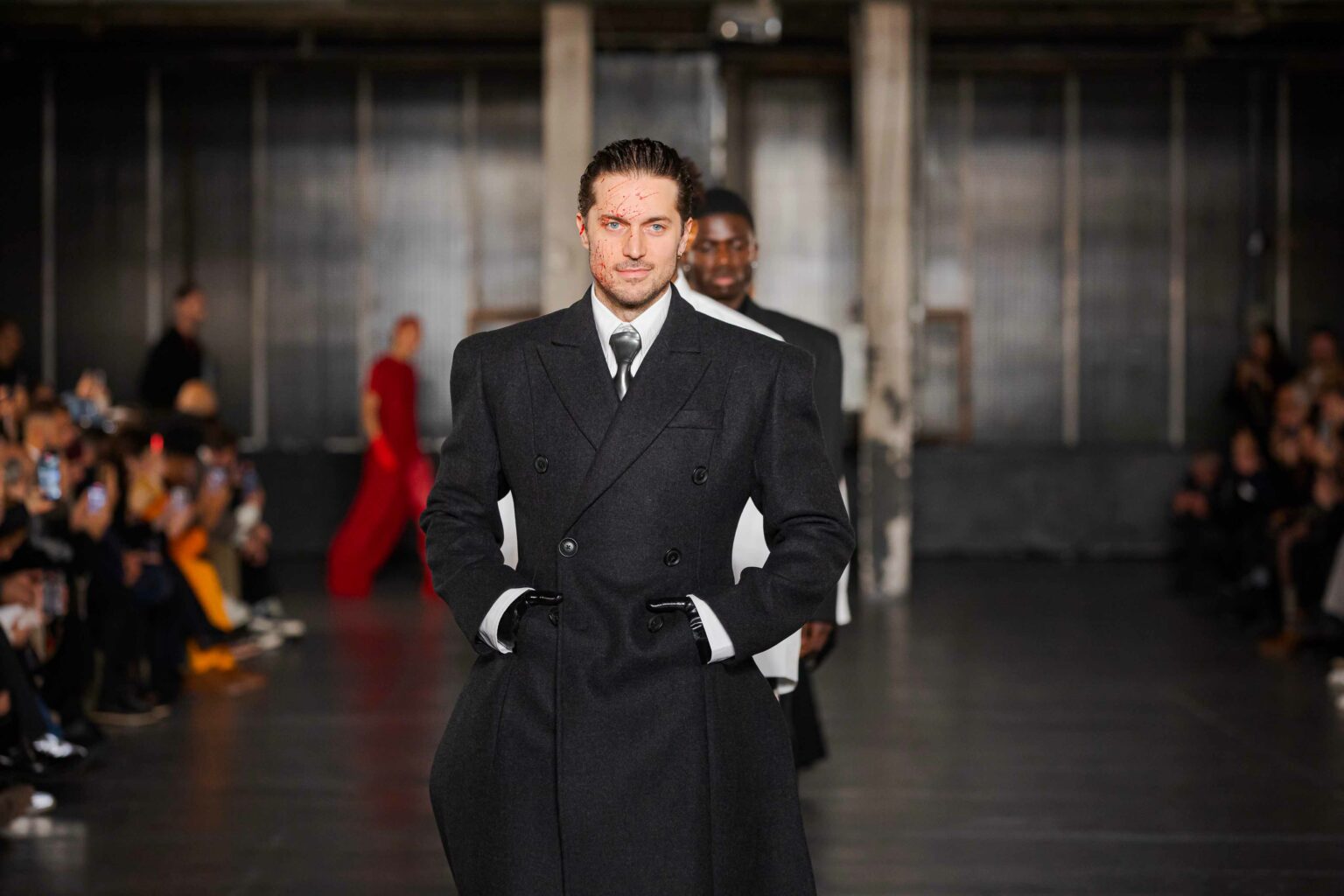Louis-Gabriel Nouchi’s American Psycho
By Paul McLauchlan
For Fall Winter 2023, Louis-Gabriel Nouchi is expanding on his library of literary references taking inspiration from Brett Easton Ellis’s American Psycho. The French designer illuminated the themes of the novel – the perilous effects of consumerism and toxic masculinity – under his signature sensual and sexy framework. However, one should not expect to find the nefarious Patrick Bateman looming over the collection; rather, Nouchi has proposed a revisionist history which interrogates the notion of power dressing.
While the designer explored tailoring and office dressing with the 1980s in mind, he avoids trite or traditional renderings of these essential men’s garments. He subverts the stereotypical wardrobe associations with notably exaggerated shoulder lines and nipped waists. Nouchi uses drapery to create warped shapes that suggest gnarly ends with fabric creating tension across the form. What’s more he presents modern notions of masculinity with a diverse and inclusive casting – a mix of friends, celebrities, and customers from his Paris store – that encompasses various body types. Patrick Bateman would recoil at the openness of it all.
“We always try to do new things without changing too much at the same time. It’s natural because we have the book to guide us and challenge us creatively; and after that, you follow the intention and the reality of the customer,” he said on a video call from his Paris studio.

What would you like us to know about this collection?
The collection is always about how you show skin or not and how provocative you can be without showing any part of the skin. At LGN, we are inspired by books so it’s like we’re building our own library. The choice of books is not so innocent, so the persona is the same from collection to collection. With American Psycho, there is plenty of material regarding the history and the universe wrapped around the book. We wanted to work around this idea of toxic masculinity, what society expects from us as men, and how we can push against this barrier you still have in menswear. We wanted to have the point of view of the victims in the book and, as a victim, taking revenge from toxic masculinity, so we’re playing with the idea of power, the connotations of suits, and there’s also drapery.
How would you characterise your evolution as a designer?
I’m obsessional, so we’ve [evolved] a lot in terms of everything. We’ve had a store in Paris for two and a half years now so we’re really starting to get to know our customer base; they’re very supportive, which is why I like to put them on the runway. In terms of design, the size of the collection is more accurate; we try to narrow it down as much as possible to make it clearer. We like to have one idea we want to express in the entire collection. We’re becoming more mature regarding the fabric choices, cuts, and size range. It’s been a constant evolution since the beginning of the brand.
How intentional are you about evolving creatively – how do you think about this when beginning a new collection?
It’s a balance. There are the shapes we love and that we want to continue such as items that have been here since the first season – pants, T-shirts, tank tops – and we change the material. Even when we mix them with new things, we have a different point of view. It’s an infinite cycle. We have very strong guidelines on the book choice. Creatively, I like to have this framework to be even more creative and it allows us to create challenges, because we like to evolve as a design team, and in production, communication…

The brand is very driven when it comes to diversity, inclusion, and acceptance. You perform it in a way that’s both sensual and provocative. How do you perceive those things?
Fashion is about society but I don’t think you have a lot of diversity and representation in the industry. I like to provoke debate, so what’s interesting for us is to present this in a way that is very in-your-face and something that is poetic and sensual because you can be several things yourself. The signature of the brand is showing part of the skin which is already a statement because it makes the skin central, even if it’s not an erotic area. The brand allows you to be sexy if you want to be sexy, sensual if you want to be sensual, but also formal if you want to be formal. Specifically in France, we are a very diverse country, so for us, it becomes a reality of the brand. It should be reflected on the runway.
How would you like to see the brand evolve in the next five years?
Still here and still independent, which is a key value of the brand. I would like to continue with what we’re doing with our retail strategy, with the store and e-commerce becoming stronger. We want to open in different retailers who are partners and real supporters of the brand and can help us grow and evolve.
This interview has been lightly edited for length and clarity.



